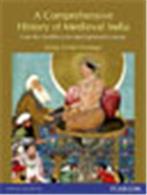A Comprehensive History of Medieval India: From Twelfth to the Mid-Eighteenth Century

|
Author(s):
Author:
Salma Ahmed Farooqui
- ISBN:9788131732021
- 10 Digit ISBN:8131732029
-
Price:Rs. 700.00
- Pages:440
- Imprint:Pearson Education
- Binding:Paperback
- Status:Available
-
|
Departing from the conventional accounts of the history of medieval India Salma Ahmed Farooqui's A Comprehensive History of Medieval India presents a consolidated timeline from the pre-sultanate period to eighteenth century India by taking into account the period that marked the end of ancient India, and focusing on the importance of the transitory centuries when Delhi, with its strategic location, had begun to surface as the new power centre. This book analyses the nature of social forces, complexity of causation and the interdependence of change and continuity in the light of the crucial transition from ancient to early medieval India, with the emergence of the Delhi Sultanate and the Vijayanagar–Bahmani kingdoms. Proceeding to detail the most effervescent period in Indian history—the era of the great Mughals—the text provides an insight into the ideological–philosophical basis of the times, focusing on the Sufi and Bhakti movements, and culminates with the rise of the Marathas, the advent of European companies, and the eventual establishment of the British in Bengal.
Keeping in mind that the history of medieval India has not moved in a linear fashion, and that much of the period saw phases of expansion and realignment of political attributes, this book contributes to a deeper understanding of the much misread period of Indian history with a view that takes into account the resultant interface between the political, social, economic, religious and cultural elements and devotes to this crucial period the attention it deserves.
Table of Content
List of Maps and Images
A Note on the Spellings
Preface
About the Author
Acknowledgments
Introduction
PART I Transition from Ancient to Medieval India
- Survey of Sources in Medieval Indian History
- Early Medieval India
- Conditions in India during the Pre-Sultanate Period
PART II Northern India Under the Delhi Sultanate
- Early Muslim Invasions
- Foundation and Consolidation of the Delhi Sultanate
- The Khiljis
- The Tughlaqs
- Decline of the Delhi Sultanate
- State and Society under the Delhi Sultans
PART III The Kingdom of Vijayanagar
- A Political Profi le of Vijayanagar
- Contours of the Vijayanagar State
PART IV The Bahmani Kingdom and the Deccani Sultanates
- Political Developments in the Bahmani Kingdom
- Administrative, Socio-Economic and Religious Conditions of the Bahmani State
- The Bahmani Successor States
PART V Religious Thought in Medieval India
- Bhakti Ideology
- Sufi Thought
PART VI The Mughal Empire
- Establishment of Mughal Rule in India
- Humayun and the Sur Interlude
- Akbar the Great
- Jahangir and Shah Jahan
- Aurangzeb
- Mughal Administration
- Socio-Economic and Religious Conditions in Mughal India
- Literature, Architecture and the Allied Arts under the Mughals
- Decline of the Mughal Empire
PART VII Rise of the Regional Powers
- Ascent of the Marathas under Shivaji
- Rise of the Peshwas
- Emerging Regional States
PART VIII Advent of the Europeans and Establishment of British Rule in India
- Advent of the Europeans
- Establishment and Consolidation of British Power in Bengal
- Ideologies and Tools of Colonial Expansion
- British Confrontation with Native and Neighbouring States
- Eighteenth Century India: Economy and Society
Further Readings
Credits
Index
|
Salient Features
- Extensive documentation covering 800 years of history
- Over 30 maps to aid the students visualize the changing political geography
- Over 40 photographs and paintings depicting the centuries of rich heritage
- Boxed items on key terms and concepts
- Dynastic chronologies and historical timelines
- Part-opening vignettes that recount historical anecdotes
- Chapter-end summaries to aid revision
- Keywords to identify and analyse the vital concepts
- Questions for review and discussion
|
|
|
|
|